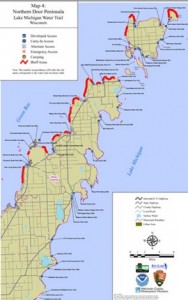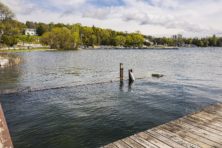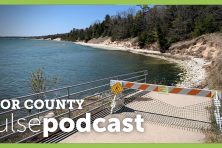Lake Michigan Water Trail Project Moves Forward
- Share
- Tweet
- Pin
- Share

Maps of the Lake Michigan Water Trail route show places for kayakers to camp and launch on their trip along the shore. Map courtesy of the Wisconsin Department of Natural Resources.
One man’s passion for paddling has turned into a 450-mile trail along Wisconsin’s Lake Michigan shore.
John Browning, of Milwaukee, took up sea kayaking in the early 1990s. He began to paddle Lake Michigan’s shores and started researching water trails around the country.
“My passion grew,” Browning said. “I thought it’d be really cool to have a Lake Michigan water trail.”
Now, with the help of the Wisconsin Department of Natural Resources (DNR), the National Parks Service, the Wisconsin Coastal Management Program and the Bay-Lake Regional Planning Commission, the project has moved from one man’s dream to a statewide initiative.
“There’s been a lot of big support on this one from Washington down to local level, in terms of trying to get this trail established,” said Jeff Prey, senior planner with the state parks system.
The first phase of the project, finding access points and shoreline campsites, was completed in 2012, Prey said.
The goal is to have an access point every five miles and campsites every 20 miles, Browning said. Most kayakers cruise at about 4 miles per hour, so it would take about an hour to get from one access point to another and five to get to each campsite.
Sometimes getting campsites every 20 miles is tough, especially in Door County. High bluffs and long stretches of privately-owned property mean long hauls for kayakers on the trail. The only appropriate campsites the trail planning committee found in northern Door County were at Newport State Park, Rock Island and Peninsula State Park.
But the team working on the trail thinks it’s important to find and develop enough campsites, because a Lake Michigan Water Trail could increase tourism in shoreline communities like Door County.
“The idea of getting access from Door County to Lake Michigan has an important tourism connection, and actually having people be able to have that access from the land to the water is important for the state,” Prey said.
Browning insists that kayak traffic would bring money to lakeshore communities.
“When we travel, we drive with our kayaks, we launch, we buy gas, we stay overnight, we have meals,” he said. “It’s just another thing communities along the lake can use – say ‘we’re on the water trail, come kayak our clean waters, and while you’re here visit the town.’”
Branding and promoting the trail is the next step in the project, and that’s the part that will help tourism most, said Casey St. Henry of Bayshore Outfitters.
“If no one knows about it no one’s going to use it,” St. Henry said.
St. Henry helped identify good places to launch kayaks in Door County. While he thinks the trail will draw serious paddlers, he’s not sure if it will be as popular as other state and national trails, like the Appalachian Trail.
“Anyone can walk, but paddling requires a certain set of skills,” he said. “It has the potential to be something really interesting if it’s advertised and marketed and people know about it.”
Browning said the positive impacts of the trail will go beyond local economies. People who have connections with an area are more inclined to protect it, so giving them another opportunity to connect with Lake Michigan will help make them conservation minded.
“People become more aware of the opportunities on the water, and more people start using the water,” Browning said. “As more people use the water they take more of an interest in things like having clean water.”
Prey said the Wisconsin trail will someday be part of a bigger initiative – a loop around the entire Lake Michigan.
While the project isn’t finished, maps of trail segments and other information are available on the DNR website.



